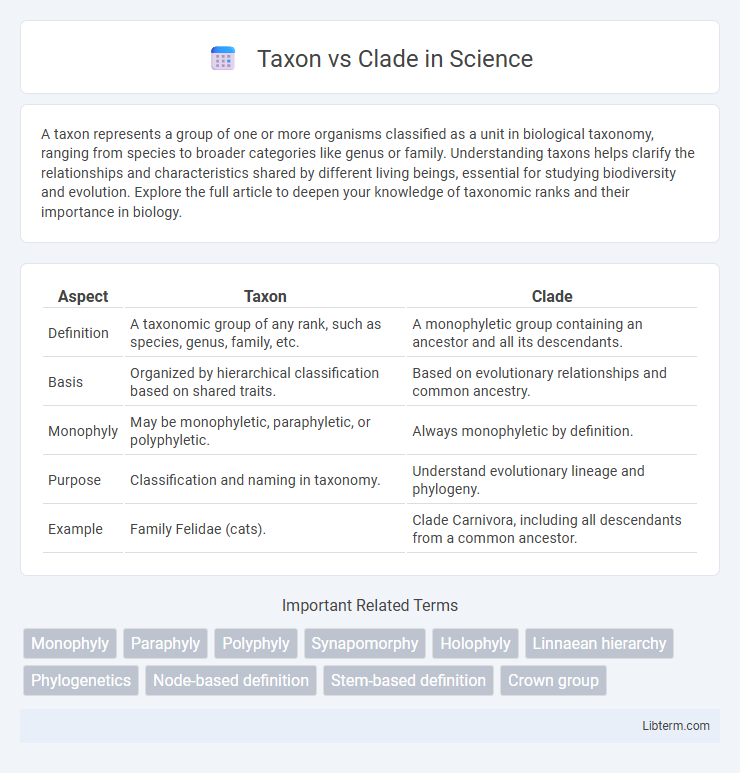A taxon represents a group of one or more organisms classified as a unit in biological taxonomy, ranging from species to broader categories like genus or family. Understanding taxons helps clarify the relationships and characteristics shared by different living beings, essential for studying biodiversity and evolution. Explore the full article to deepen your knowledge of taxonomic ranks and their importance in biology.
Table of Comparison
| Aspect | Taxon | Clade |
|---|---|---|
| Definition | A taxonomic group of any rank, such as species, genus, family, etc. | A monophyletic group containing an ancestor and all its descendants. |
| Basis | Organized by hierarchical classification based on shared traits. | Based on evolutionary relationships and common ancestry. |
| Monophyly | May be monophyletic, paraphyletic, or polyphyletic. | Always monophyletic by definition. |
| Purpose | Classification and naming in taxonomy. | Understand evolutionary lineage and phylogeny. |
| Example | Family Felidae (cats). | Clade Carnivora, including all descendants from a common ancestor. |
Introduction to Taxon and Clade
A taxon is a group of one or more organisms classified together based on shared characteristics, serving as a unit in biological classification or taxonomy. A clade represents a group of organisms that includes an ancestor and all its descendants, emphasizing evolutionary relationships through common ancestry. Understanding taxa involves categorizing species into hierarchical ranks such as genus or family, while clades focus on phylogenetic lineage within evolutionary biology.
Defining Taxon: Traditional Classification
A taxon represents a group of one or more populations of organisms classified together based on shared characteristics, following traditional taxonomy methods such as morphological traits and hierarchical ranks (kingdom, phylum, class). Traditional classification defines taxa by observable features and evolutionary relationships inferred before molecular phylogenetics became prevalent. These taxa serve as fundamental units in biological nomenclature but may not always correspond to monophyletic clades defined strictly by common ancestry.
What is a Clade? Concepts in Phylogenetics
A clade refers to a group of organisms that includes an ancestor and all its descendants, representing a single branch on the tree of life in phylogenetics. Unlike taxa, which can be arbitrary groupings based on various criteria, clades specifically reflect evolutionary relationships derived from common ancestry. Clades are fundamental in understanding evolutionary history because they depict monophyletic groups, crucial for reconstructing phylogenetic trees.
Key Differences Between Taxon and Clade
Taxon represents any group of organisms classified together based on shared characteristics, often forming a hierarchical rank in taxonomy such as species, genus, or family. Clade refers specifically to a group of organisms that includes an ancestor and all its descendants, highlighting evolutionary relationships through common ancestry. The key difference is that taxon classification may not always reflect evolutionary lineage, while clades strictly represent monophyletic groups based on phylogenetic evidence.
Historical Context: Taxonomy vs Cladistics
Taxonomy, originating with Carl Linnaeus in the 18th century, classified organisms based on morphological similarities and hierarchical ranks, emphasizing observable traits and overall resemblance. Cladistics, developed in the mid-20th century by Willi Hennig, introduced a phylogenetic approach focusing on shared derived characteristics (synapomorphies) to reconstruct evolutionary relationships and define clades as monophyletic groups. The historical shift from traditional taxonomy to cladistics reflects a move from phenetic classification toward a more evolutionary-based framework grounded in common ancestry and lineage divergence.
Examples of Taxa and Clades in Biology
Taxa such as Mammalia, Aves, and Reptilia represent classification groups based on shared characteristics, often including multiple clades within them. Clades like the Amniota clade, which includes reptiles, birds, and mammals, are monophyletic groups consisting of a common ancestor and all its descendants. The distinction highlights that while taxa can be paraphyletic or polyphyletic, clades strictly represent evolutionary lineages validated by phylogenetic analysis.
Importance of Monophyly and Paraphyly
Monophyly is crucial in taxonomy and cladistics because it ensures a clade includes an ancestor and all its descendants, providing accurate evolutionary relationships. In contrast, paraphyly groups organisms that share a common ancestor but excludes one or more descendant groups, leading to incomplete or misleading classifications. Recognizing monophyletic groups supports consistent taxonomy aligned with evolutionary history, while paraphyletic groups highlight the need for taxonomic revision to reflect true phylogenetic relationships.
Applications in Modern Biological Classification
Taxon and clade are fundamental concepts in modern biological classification, where a taxon represents any rank or group in a hierarchical system, such as species, genus, or family, used to categorize organisms based on shared characteristics. A clade specifically refers to a monophyletic group consisting of an ancestor and all its descendants, emphasizing evolutionary relationships derived from common ancestry. Applications of these concepts include constructing phylogenetic trees and improving the accuracy of classification systems by integrating genetic data to reflect true evolutionary history.
Controversies and Debates: Taxon vs Clade
Taxon refers to a group of organisms classified based on shared characteristics, often resulting in paraphyletic groups, whereas a clade consists of an ancestor and all its descendants, representing monophyletic groups in phylogenetics. Debates arise over taxonomic classifications when traditional taxa do not align with clades derived from molecular data, challenging established hierarchies in systematics. Controversies persist regarding the emphasis on phylogenetic accuracy in clade-based classification versus the practicality and historical context of taxa, impacting nomenclature stability and evolutionary interpretations.
Future Directions in Systematics and Classification
Future directions in systematics emphasize integrating genomic data to refine the distinctions between taxon and clade, enhancing resolution in evolutionary relationships. Advances in bioinformatics and phylogenomics enable more accurate clade identification that reflects true common ancestry, moving beyond traditional taxon-based classifications. Emerging computational tools promise dynamic, database-driven taxonomies that adapt as new genetic information reshapes our understanding of biodiversity.
Taxon Infographic

 libterm.com
libterm.com